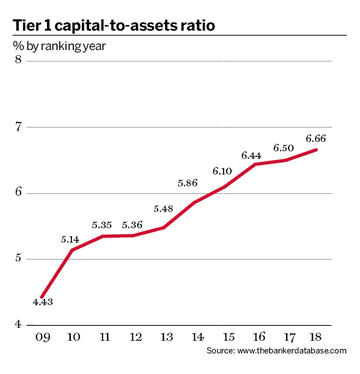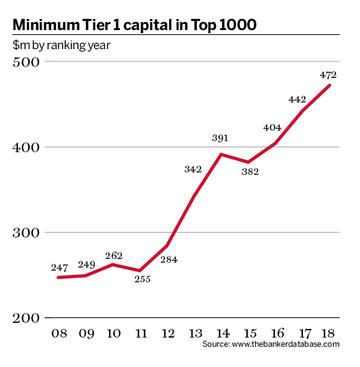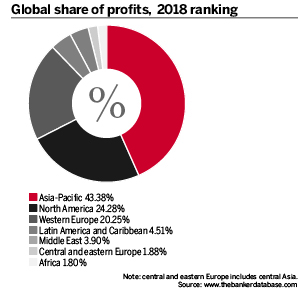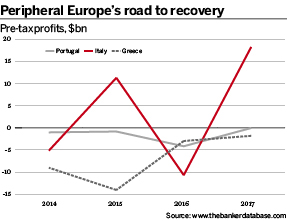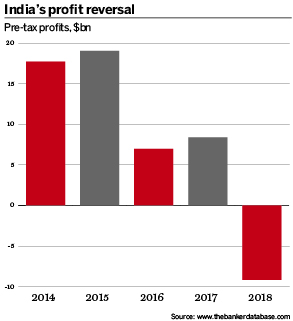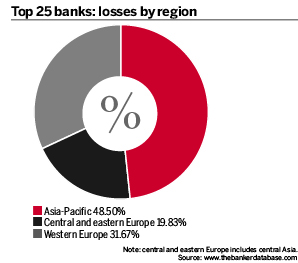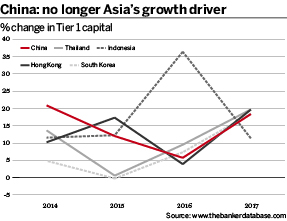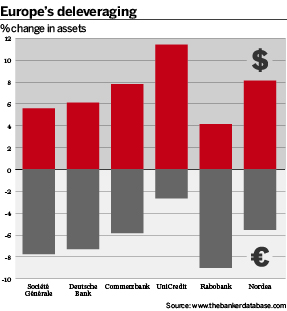Exactly 10 years after the suspension of three US mortgage-focused funds signalled the start of the global financial crisis, the banking industry appears to be finding its feet. The banks in The Banker's Top World Banks ranking for 2018 recorded double-digit growth in both capital and pre-tax profits, a feat not seen since 2010 when it was working from a much lower base.
Together, the world’s largest 1000 banks hold nearly 12% more Tier 1 capital in the 2018 ranking than they did in the 2017 version, marking the biggest annual increase since 2009. An even more reassuring sign of the industry’s resilience is that capital is growing at a faster pace than assets. This is revealed by the global capital-to-asset ratio, a variant of Basel’s 3% leverage ratio, but which excludes off-balance-sheet items, rising 16 basis points (bps), compared with a more modest 6bps one year ago.
Top 1000 aggregates
| 2018 ($bn) | 2017 ($bn) | change from previous year | |
| Aggregate Tier 1 | 8,235 | 7,374 | 11.67% |
| Aggregate total assets | 123,653 | 113,487 | 8.96% |
| Aggregate pre-tax profits | 1,112 | 962 | 15.57% |
| Profits/Tier 1 (%) | 13.50 | 13.04 | 46bps |
| Return on assets (%) | 0.90 | 0.85 | 5bps |
Broad-based growth
China’s biggest banks were key contributors to 2017’s capital surge, with its top four lenders growing their collective Tier 1 capital base by $144bn. Bank of China and Agricultural Bank of China have leapfrogged JPMorgan Chase and Bank of America, seeing China claim the top four spots for the first time. It cements banking’s new world order, an order that is no longer dominated by the US.
But the capital rush is happening at both ends of the spectrum. The smallest bank in the rankings holds $472m in Tier 1 capital (five years ago it would have ranked 877th). But for The Banker’s decision to exclude Venezuelan banks from this year’s ranking due to hyperinflation distorting their financial results, the entry threshold would have been nearly $500m.
The capitalisation surge knows no borders, either. Except Latin America and the Caribbean, all regions posted double-digit Tier 1 capital growth in 2017. Just like the global economy, the banking sector appears to be staging a broad-based recovery.
The proof in the profits
This recent capital performance is, of course, simply the acceleration of a near-decade-old trend sparked by the need to rebuild balance sheets after the crisis. What is more interesting is that profit showed a similar pick-up in the 2018 rankings.
After sliding over the 24 months prior, global pre-tax profits jumped 15.6% to reach $1112bn. The Top 1000 banks’ collective return on equity (ROE) – the best yardstick of profitability – jumped to 11.82%, at the upper end of the 10% to 12% bracket that banks typically strive for. Furthermore, the biggest moves from loss to profit in the 2018 rankings are more than four times the size of the previous ranking’s best recoveries.
As with capital, profits in every region and major market are up from (or broadly on par with) the 2017 rankings. Even Japanese banks, whose margins continue to suffer under the Bank of Japan’s long-running negative interest rate policy, improved profits by 7.6%. In central and eastern Europe, the Middle East and China, profits were outpaced by capital and asset expansions, so their ROE and return on assets (ROA), another key profitability metric, have dipped a few basis points.
A region to watch is North America. Profitability at all Canadian banks in this year’s ranking spiked at least 15%. Their collective ROE is a whopping 16.92%, while their ROA and return on capital far exceed the global average. In 2018 their peers south of the border will start reaping the benefits of a boost in business activity thanks to the US corporate tax rate being slashed from 35% to 21%.
Regions by total Tier 1/assets/pre-tax profits
| Tier 1 capital | Assets | Pre-tax profits | |
| China | 2,057 | 29,019 | 322 |
| US | 1,406 | 16,055 | 225 |
| Eurozone | 1,395 | 26,134 | 137 |
| Japan | 686 | 13,485 | 55 |
| UK | 412 | 7,522 | 37 |
Europe’s revival
The rosy profitability score in 2018’s Top 1000, however, is underpinned by an unlikely candidate. Western Europe, which in the 2017 ranking was home to the 10 biggest loss-makers and which is often censured for lagging behind the US, has bounced back with a vengeance. Regional profits grew by more than 67% and ROE leapt three percentage points to 8.6%. It has led to a more even distribution of the global profit pie; Europe’s share has soared to 20.3%, a five-year high and just four percentage points shy of North America.
Western Europe’s biggest banking markets are key drivers. France cemented its reputation as the engine of European banking, growing profits by 18.5% to achieve ROE of 9.4%. The UK more than doubled its 2017 ranking profits; the only other country in the 2018 rankings with a more impressive profit turnaround is Uzbekistan, which is represented by just one bank.
The UK’s comeback is largely down to HSBC, which reversed its 62% profit slide in 2016; Standard Chartered, which grew returns fivefold; and RBS, which turned in its first profit in a decade despite paying US regulators $5.5bn to settle crisis-era mis-selling claims. In Germany, and across the eurozone as a whole, profits also more than doubled. Even German national champion Deutsche Bank, notwithstanding its strategy dilemma and leadership overhaul, posted a $1.5bn profit – its first in three years.
Deutsche Bank, RBS and Credit Suisse – which were repeat offenders on the 2017 ranking of biggest loss-makers – are among the top turnaround stories for the 2018 list. They are joined by five other European names, four of which are from the biggest loss-making countries in the 2017 ranking. Dogged by non-performing loans (NPLs) and the lingering effects of the eurozone crisis, Italy, Greece and Portugal have long-been Europe’s underperformers. But in the 2018 rankings their fortunes improved, resolutely led by their biggest banks.
Southern Europe's comeback
Italy’s ROE jumped from -9.8% in the 2017 ranking to be on par with Luxembourg and Switzerland, and just shy of western Europe’s average. Nearly all of its lenders turned a profit, a vast improvement on the 2017 ranking, when almost half posted a loss. A key contributor was the nationwide NPL selling spree, which has allowed banks to cut their impairment charges and provisions (ICP), the loss recognised on loan books to account for impaired assets, and pushed Italy out of the list of countries with the highest ICP-to-income ratios. Undoubtedly, UniCredit staged the most impressive turnaround. A €13bn rights issue saw it reclaim its status as the country’s biggest bank, and it turned a $10.9bn loss into a $7.8bn profit, thanks in no small part to the sale of a €17.7bn NPL portfolio and subsequent $11bn reduction in ICP.
Regional aggregate profitability
| Region | ROA (%) | ROE (%) | ROC (%) |
| Africa | 2.12 | 21.08 | 26.40 |
| China | 1.11 | 15.29 | 15.64 |
| Japan | 0.41 | 7.32 | 8.03 |
| Asia Pacific (excl China and Japan) | 0.82 | 10.03 | 11.61 |
| Central and Eastern Europe | 1.48 | 12.56 | 13.61 |
| Western Europe | 0.56 | 8.62 | 10.19 |
| Middle East | 1.52 | 11.97 | 13.03 |
| North America | 1.33 | 13.32 | 16.70 |
| LatinAmerica | 1.93 | 20.94 | 25.76 |
Portugal posted a loss in the 2018 rankings, but it is a sliver of the $3.65bn loss reported in its 2016 financial results. If it weren’t for one bank – Novo Banco, which posted the 11th biggest loss globally – the sector would have made a sizeable profit. It still managed to bolster its capital cushions by 30.4%, and but for Novo Banco, the national NPL ratio would have shrunk.
The Portuguese banking sector has offloaded NPLs via securitisation and sales, but the market has been underwhelming to date. The fact that ICPs have shrunk by nearly one-third and the ICP-to-income ratio has halved is cause for cautious optimism that NPL stocks will continue to fall. The sector has been dragged up by Caixa Geral de Depósitos (CGD) and its €5bn state-supported recapitalisation in 2017. CGD has recovered its crown as Portugal’s biggest bank and posted its first profit since 2010. As at UniCredit, this was aided by cutting its ICP by three-quarters.
Greece’s improvements are more modest, but still worthy of note. The sector-wide NPL ratio dropped eight percentage points, pre-tax losses shrunk from $3bn to less than $2bn, and Tier 1 capital increased by 10%. ICPs continued to rise, though, suggesting there is still a long road ahead in tackling its NPL problem. Its biggest lender, Alpha Bank, seems to embody the sector’s state of health. It added $100m in profits but lays claim to the world’s fourth highest NPL ratio, despite shaving off a few percentage points in 2017.
India’s woes
There is one glaring exception to the glowing returns reported in the 2018 ranking: India. Only half of its banks managed a profit and the sector collectively posted a $9.2bn loss. The country is home to 48% of the Top 1000's loss-makers and dominates the table of biggest losses. For two of these lenders – Punjab National Bank and Canara Bank – it has been a rollercoaster ride, with them having been among the top 10 biggest recoveries in 2017’s rankings.
The sector’s deterioration has occurred in two stages, and is undoubtedly linked to the Reserve Bank of India (RBI) pressuring state-owned banks to recognise and deal with the NPLs bloating their balance sheets. The RBI’s clampdown started in late 2015, following which country-wide profits diminished by two-thirds. They then edged up a fraction, before plummeting in the 2018 rankings.
The Banker’s results justify the RBI’s concerns, but also suggest the sector has heeded its warnings. Indian names dominate the list of highest disclosed NPL ratios for the first time; the banks that feature saw their ratios jump between five and 10 percentage points. ICPs and profits have grown at the same trajectory but in the opposite directions, which suggests that provisioning for NPLs is a major cause of the sector’s dwindling returns. In 2017, losses were more pronounced as revenues were relatively flat. ICP wiped out more than half the sector’s operating income, landing India in fourth place in the list of highest ICP-to-income ratios.
Otkritie at a loss
But India does not lay claim to the biggest loss-maker; that title belongs to Russia’s Otkritie Financial Corporation, which was the country’s fifth biggest lender before sliding nearly 350 places in the 2018 rankings. Its $7.5bn loss is largely attributable to its soaring ICP, which single-handedly landed Russia on the highest ICP-to-income list.
Profits are not Otkritie’s biggest worry, though. Following a run on its deposits in mid-2017, which amounted to the fourth biggest decline in deposit funding in the 2018 ranking, what was once the country’s biggest private lender became the subject of its biggest ever bailout. The central bank has since announced its intention to merge Otkritie with another rescued lender, B&N, before selling it in the market.
Ten biggest moves from loss to profit
| Bank Name | Pre-tax profits | Previous pre-tax loss | Recovery |
| UniCredit | 7,823 | -10,884 | 18,706 |
| RBS | 3,026 | -5,040 | 8,065 |
| Banco BPM | 3,021 | -2,418 | 5,439 |
| Credit Suisse Group | 1,830 | -2,222 | 4,051 |
| Deutsche Bank | 1,480 | -853 | 2,332 |
| Korea Development Bank | 1,444 | -696 | 2,139 |
| UBI Banca | 959 | -1,226 | 2,185 |
| Fukuoka Financial Group | 666 | -317 | 984 |
| Raiffeisenlandesbank NO Wien | 650 | -63 | 713 |
| Millennium BCP | 384 | -248 | 632 |
In stark contrast to recent years, there is a notable absence of top-tier lenders in the list of heftiest losses. The biggest name is State Bank of India, ranked 56th overall, followed by Italy’s beleaguered Monte dei Paschi, which is in rehabilitation after its state-backed recapitalisation in 2017. Big Western banks do not feature because their extensive post-crisis restructures are drawing to an end, along with their multi-billion-dollar payments to US authorities to settle crisis-era mis-selling allegations.
Research by Boston Consulting Groups found that financial penalties paid by North American and European banks in 2017 were down 48% on the previous year. RBS and Barclays’ payments of $4.9bn and $2bn, respectively, to the Department of Justice in 2018 effectively close the book on Wall Street’s crisis-related penalties. A decade after the fallout began, investment banks’ balance sheets appear to be entering a new era.
Of course, some Western bulge-bracket banks made pre-tax profits but after tax losses for financial year 2017, including Citigroup ($6.2bn loss), Barclays (£1.9bn/$2.5bn loss) and Credit Suisse (SFr983m/$993m loss). But these were caused by one-off write-downs due to accounting technicalities arising from the US’s sweeping tax reform.
Last year’s Top 1000 results suggested that the quality of Cypriot loan books could be improving, as ICP-to-income was heading south. Unfortunately, that ratio doubled in 2017, landing Cyprus at the top of the ICP table. Yet this is solely down to Bank of Cyprus, which increased provisions by 130%. Hellenic Bank, the country's only other name in this year’s rankings, cut its ICP-to-income ratio by 10 percentage points.
Top 25 losses by bank
| World rank | Bank name | Pre-tax loss ($m) |
| 619 | Otkritie Financial Corporation Bank | -7,516 |
| 135 | Banca Monte dei Paschi di Siena | -5,090 |
| 230 | Punjab National Bank | -3,051 |
| 374 | IDBI | -1,921 |
| 56 | State Bank of India | -1,883 |
| 158 | Piraeus Bank Group | -1,690 |
| 253 | Bank of India | -1,331 |
| 581 | Indian Overseas Bank | -1,327 |
| 483 | Central Bank of India | -1,214 |
| 711 | Unipol Banca | -1,200 |
| 248 | Novo Banco | -1,150 |
| 586 | Corporation Bank | -1,026 |
| 282 | Union Bank of India | -1,016 |
| 574 | Allahabad Bank | -1,013 |
| 221 | Canara Bank | -985 |
| 527 | Oriental Bank of Commerce | -937 |
| 521 | Andhra Bank | -840 |
| 593 | UCO Bank | -681 |
| 423 | Banca Carige | -668 |
| 378 | Syndicate Bank | -658 |
| 381 | Bank of Cyprus | -575 |
| 363 | Liberbank Group | -547 |
| 209 | HSH Nordbank | -546 |
| 182 | Dexia | -541 |
| 680 | Bank of Maharashtra | -502 |
Asia Pacific’s new drivers
After stalling a little in the 2017 ranking, China’s banks continued to grow at a ferocious pace. Over the course of 12 months, China Construction Bank added the Tier 1 capital-equivalent of RBC, Canada’s biggest bank, to its balance sheet. ICBC grew by an amount equal that of the country’s second biggest lender, Toronto Dominion Bank. But for a collapse or crisis, there seems little chance of Chinese names being dislodged from the top four positions any time soon. With Bank of Communications, currently ranked 11th, growing capital at three times the pace of the biggest US names, it looks set to climb further up the leaderboard as well.
China’s headline numbers are impressive but Asia’s other finance hubs are expanding at a similar rate, albeit with less fanfare. South Korea is a case in point; for the past two years, its capital growth has outstripped that of China’s. In the 2018 rankings Hong Kong and Thailand set the pace in Asia-Pacific, however, building their capital buffers by 19.7%.
The more advanced financial sectors have broadly followed the same trajectory, plateauing for two years before spiking in the 2018 rankings. Indonesia, however, is forging its own path. Lenders in south-east Asia’s biggest economy have consistently posted double-digit growth, hitting a 36% high in the 2017 rankings, as they work to meet higher capital requirements imposed by the central bank.
The trend rings true for assets, too. In 2017, holdings at South Korean, Singaporean, Taiwanese and Thai banks outpaced that of China’s. Over the past four years, Indonesia has matched China’s 47.5% expansion. Admittedly, these countries are starting from a lower base, both in terms of capital and assets, so their gains in absolute terms are less dramatic. But it means their growth is more sustainable over the medium to long term. Furthermore, the opacity of China’s economy makes it difficult to verify official statistics and detect dangers lurking in its financial system.
Top 10 countries for total impairment charges
| Country | Proportion of total operating income (%) | Change year on year (basis points) |
| Cyprus | 80.42 | 3882 |
| Greece | 60.24 | 1464 |
| Portugal | 56.21 | -5589 |
| India | 54.53 | 1378 |
| Belarus | 38.52 | 25 |
| Russia | 34.33 | 559 |
| Spain | 25.66 | 147 |
| Ecuador | 25.45 | 279 |
| Colombia | 25.28 | 742 |
| Kuwait | 25.11 | 136 |
Europe’s shrinking asset base
While Asia’s banks are bulking up, many of Europe’s have spent the past few years trying to downsize. They have done this by creating and then closing non-core units, exiting business lines and selling underperforming asset portfolios to become simpler, leaner and more focused on their strengths. Yet The Banker’s Top 1000 methodology, which converts figures to US dollars to create a comparable ranking, belies the success of their efforts in 2017. This is because the euro, in which they report, gained 12.6% against the dollar to become the year’s best performing currency. The rankings suggest European bank assets grew 11.4%, but a euro-denominated analysis of a sample of the region’s biggest lenders paints a different picture.
The best example is Deutsche Bank, which is in the throes of scaling back its troubled investment banking operations. In dollar terms it appears that Deutsche added 6.1% in assets during 2017, when in reality they diminished 7.3%. Compatriot Commerzbank shrunk nearly 6% in pursuit of its goal to run down non-strategic assets. Further north, Nordea rationalised its balance sheet by 5.5% while Rabobank cut nearly 10% of its assets. What looks like a double-digit expansion at UniCredit is actually a 2.7% drop, while Société Générale is nearly 8% smaller than in the 2017 rankings.
The US dollar index falling from its decade-high in 2016 partly explains why just four countries posted asset declines in 2017. Furthermore, these figures are a fraction of the up to 50% falls reported in the 2017 rankings, and are based on the results of just 11 firms. It is yet another reflection of the global banking industry’s solid performance.
The US dollar’s decline means foreign exchange swings have not rattled the overall leaderboard. Only four countries have suffered due to depreciating currencies, and all their banks sit outside the top 100. Spare a thought for Turkish banks, though, which have been hit two years running. The lira dipped 7.4% in 2017 after losing 21% against the US dollar the previous year. But for these consecutive declines, both TC Ziraat Bankasi and Turkiye Is Bankasi would have cracked the top 100. It is a credit to both that in 2017 they managed to grow capital cushions in dollar terms.
Argentina’s banks find themselves in a similar situation. The peso finished the year 17% down against the US dollar, after losing 21.4% in 2016. This masks the strides made by its second biggest bank, Banco Macro, which has climbed nearly 200 places over the past two years despite its collapsing currency. But for 2017’s currency moves, it would have climbed another 60 spots. Given the peso hit a historic low in May 2018 after the International Monetary Fund agreed to extend Argentina a record-breaking $50bn loan, there seems little chance of the currency staging a recovery any time soon.
Assets versus liabilities
In the 2018 rankings, the lender hit hardest by declining deposits is First Energy Bank. The small Bahraini outfit, dedicated to the region’s troubled oil industry, had 44% of its deposits pulled in 2017. As a percentage of liabilities it is the world’s third sharpest drop in as many years, but concerns are mitigated by the fact it follows a spike in deposits in 2016.
On the flipside, it more than halved its risk-weighted assets (RWA), meaning it de-levered more than any other bank in the 2018 rankings. With a RWA density of nearly two-and-a-half times the global average, though, it still has room to improve. Another Bahrain-based Islamic investment bank is a bigger concern. GFH Financial Group nearly doubled its RWAs in 2017, due to increased credit exposure to development and investment properties. It shaved percentage points off its capital adequacy ratio and lumped it with the world’s highest RWA density.
In terms of deposit declines, two banks have been hit hard for the second year running: Belgium’s Dexia and Nigeria’s Diamond Bank. The former is being wound-down by its government owners after its 2011 rescue, but Diamond Bank has different problems. Since 2014, its deposits – among its major sources of funding – have nosedived from $9.3bn to $3.8bn, while its modest but consistent profits turned into a loss in 2017. Over the past three years, Diamond Bank has slid nearly 400 places down the overall rankings. Russia’s B&N makes the list for similar reasons to its compatriot Otkritie. The country's central bank nationalised B&N in September 2017 after, inter alia, it needed emergency liquidity after large depositors started pulling their funds.
Biggest asset declines by country
| Country | Assets decrease (%) | Total assets 2018 ($m) | Total assets 2017 ($m) |
| Egypt | -3.15 | 147,870 | 152,683 |
| Bermuda | -2.92 | 10,779 | 11,104 |
| Iraq | -2.21 | 19,300 | 19,735 |
| Greece | -0.42 | 309,141 | 310,429 |
Leading foreign networks
In 2017, the world’s biggest banking groups accounted for a larger slice of global profits than the year prior, but this is thanks to their motherships. The foreign-owned subsidiaries (FOS) that belong to the world’s 10 most successful bank groups generated a smaller proportion of global returns than in years past. It suggests that the industry’s reversal of fortunes has benefited local firms, rather than being centralised in the hands of global conglomerates.
That said, HSBC has pulled away from the FOS pack, cementing its status as the world’s pre-eminent banking franchise. Its FOS network is more than $10bn times more profitable than any other, and returns at the Hong Kong unit – its engine – are four times higher than any other FOS. Hong Kong generated 62% of HSBC’s overseas profits, down from 70% the two years prior, suggesting its revenue base is becoming more diversified.
European headquartered firms now run the world’s four most profitable bank networks, thanks to BNP Paribas having displaced Bank of China. This is partly down to its Belgian subsidiary – BNP Paribas Fortis, the country’s biggest lender – lifting profits by 41% in 2017. It is quickly closing in on Banco Santander Brasil for third place in the list of most profitable FOSs. The fact sector-wide returns in Belgium nearly halved in 2017 – indeed, the country is the exception to Europe’s profit turnaround – makes Fortis’s performance all the more impressive.
Ten most profitable foreign networks
| Parent | Number of FOS in Top 1000 | Pre-tax profits of FOS ($m) | Pre-tax profits of holding company ($m) |
| HSBC Holdings | 19 | 23,775 | 17,167 |
| Banco Santander | 11 | 13,294 | 14,567 |
| BBVA | 7 | 7,292 | 8,351 |
| BNP Paribas | 9 | 6,606 | 13,627 |
| Bank of China | 2 | 5,096 | 34,240 |
| UniCredit | 11 | 4,666 | 7,823 |
| Citigroup | 10 | 4,293 | 22,657 |
| ING Group | 6 | 4,255 | 8,920 |
| Toronto Dominion Bank | 2 | 3,165 | 9,977 |
| Standard Chartered | 9 | 2,939 | 2,415 |
ING and Standard Chartered have re-entered the foreign networks leaderboard after disappearing in 2017’s rankings. Profits at the Dutch bank’s FOSs more than doubled in 2017, propelling a 43% increase group-wide. As with BNP Paribas, this was largely down to its Brussels-based unit, whose profits soared 73%, and its German subsidiary ING DiBa. The latter is a branchless retail bank whose online-only strategy has overcome record low interest rates and an overcrowded market to become the world’s 13th most profitable FOS.
Across the Atlantic, Toronto Dominion Bank’s US subsidiary has catapulted the group into the top 10 most profitable international franchises. TD Bank US Holding Company more than doubled its pre-tax profits in two years, moving it from 13th to fifth in the list of most profitable FOSs. It suggests the US market is not as hard to crack as some European bank bosses make out.
Nordea has disappeared from the list of leading foreign networks after it converted its Norwegian, Danish and Finnish subsidiaries into branches. Barclays has followed suit, after selling the bulk of its remaining stake in Barclays Africa. Its strategy to focus on its home market and the US seems to be bearing fruit, though, with its New York-based unit turning a $1.2bn pre-tax profit to enter the top 20 FOSs.
UniCredit’s German subsidiary made the most impressive gains, though. Returns at HypoVereinsbank increased sixfold in 2017, generating $1.92bn, which amounts to nearly one-quarter of its Italian parent’s profits.
The foreign exchange effect
| Bank name | Country | Actual rank | Rank excluding FX depreciation |
| TC Ziraat Bankasi | Turkey | 117 | 112 |
| Turkiye Is Bankasi | Turkey | 122 | 117 |
| Akbank | Turkey | 139 | 132 |
| Turkiye Halk Bankasi | Turkey | 202 | 192 |
| VakifBank | Turkey | 212 | 204 |
| Banco de la Nacion Argentina | Argentina | 265 | 240 |
| Banco Macro | Argentina | 450 | 390 |
| Bank Keshavarzi (Agri Bank) | Iran | 596 | 556 |
| Habib Bank | Pakistan | 645 | 617 |
| Banco de Galicia | Argentina | 646 | 586 |
| MCB Bank | Pakistan | 667 | 648 |
| United Bank | Pakistan | 697 | 649 |
| National Bank of Pakistan | Pakistan | 749 | 723 |
| Sekerbank | Turkey | 881 | 856 |
| Allied Bank | Pakistan | 884 | 865 |
| Banco Provincia | Argentina | 885 | 830 |
| Anadolubank | Turkey | 944 | 918 |
| Banco Supervielle | Argentina | 963 | 913 |
| Banco de San Juan | Argentina | 979 | 932 |
| Banco de la Ciudad de Buenos Aires | Argentina | 986 | 937 |
| Bank Alfalah | Pakistan | 990 | 966 |
Top 10 declines in deposit funding
| Bank name | Country | change y-o-y (bps) | Deposits (% total liabilities) |
| First Energy Bank | Bahrain | -4406 | 90.97 |
| Dexia | Belgium | -3651 | 5.17 |
| National Bank of Uzbekistan (NBU) | Uzbekistan | -2406 | 31.69 |
| Otkritie Financial Corporation Bank | Russia | -2401 | 38.15 |
| Diamond Bank | Nigeria | -2334 | 78.62 |
| B&N Bank | Russia | -2118 | 57.99 |
| Banc of California | US | -2023 | 78.29 |
| Corporation Bank | India | -1714 | 86.86 |
| Bank Nederlandse Gemeenten | Netherlands | -1692 | 2.72 |
| HSH Nordbank | Germany | -1658 | 54.85 |
M&A: born out of necessity
The Top 1000’s most notable bank merger was between the United Arab Emirates’ second and third biggest lenders, National Bank of Abu Dhabi and First Gulf Bank, to create First Abu Dhabi Bank. The combined entity has debuted in 81st place, just one spot ahead of regional rival Qatar National Bank, to become the Middle East’s biggest lender by Tier 1 capital. It beat the incumbent by just $400m, so it is possible the two will tussle for the regional crown for years to come.
In 2018, rumours have circulated that a handful of top-50 ranking European banks are considering tie-ups. To date, though, bank mergers and acquisitions (M&As) across the region have predominantly been out of necessity. In mid-2017, Italy’s Intesa Sanpaolo bought the good assets of compatriots Banca Popolare di Vicenza and Veneto Banca, after the European Central Bank (ECB) declared they were failing. Banco Popolare and Banca Popolare di Milano’s merger to create the country’s third biggest bank (Banco BPM, ranked 129th overall) was prompted in part by government reforms designed to consolidate and strengthen the fragmented bank sector.
Meanwhile in Spain, home to some 40% of the region’s bank M&A since 2011, Santander bought Madrid-based Banco Popular – 156th in 2017’s Top 1000 – for a symbolic €1 after the ECB declared it failing or likely to fail. This helped Santander increase its capital by 20%, but the double-digit gains made by the banks ranking immediately above the national champion means it nudged up just one spot to finish 15th in this year’s rankings. Still on the Iberian peninsula, Portugal’s fifth largest lender, Banco Portugues de Investimento, has disappeared from the rankings after Spain’s CaixaBank increased its shareholding to take control of the firm.
As in previous years, regional US banks created lots of movement in the bottom half of the rankings, and 2017’s most notable cross-border deal saw Canadian Imperial Bank of Commerce, ranked 84th globally, buy Chicago-based PrivateBancorp.
Top five rises in risk-weighted assets
| Bank | Country | Total RWA ($m) | Increase year on year ($m) | Change (%) | RWA (% of total assets) |
| National Bank of Uzbekistan (NBU) | Uzbekistan | 8,241 | 5,622 | 214.70 | 53.61 |
| Banco BPM | Italy | 91,441 | 50,245 | 121.96 | 47.08 |
| Simmons First National Corp | US | 12,234 | 6,232 | 103.84 | 81.21 |
| Pacific Premier Bancorp | US | 6,840 | 3,331 | 94.95 | 85.23 |
| GFH Financial Group | Bahrain | 8,388 | 3,933 | 88.28 | 204.06 |
Top five declines in risk-weighted assets
| Bank | Country | Total RWA ($m) | Decrease year on year ($m) | Change (%) | RWA (% of total assets) |
| First Energy Bank | Bahrain | 1,263 | -1,413 | -52.79 | 136.29 |
| CIT Group | US | 44,552 | -20,035 | -31.02 | 90.41 |
| Indian Overseas Bank | India | 20,742 | -5,345 | -20.49 | 54.41 |
| Banco Compartamos | Mexico | 1,349 | -346 | -20.40 | 97.37 |
| Unipol Banca | Italy | 6,853 | -1,586 | -18.79 | 40.76 |
Hiring U-turns
M&A aside, firms have grown and rationalised their business organically, by changing headcount. In China there has been a clear bifurcation between the leading firms and their smaller rivals. The likes of Hua Xia Bank, Shanghai Pudong Development Bank and Industrial Bank, which place between 25th and 65th in the overall rankings, have grown headcount consistently over past four years. Yet China’s, and indeed the world’s, biggest banks are downsizing. They are no longer among the world’s biggest hirers, a list they once dominated, following the disappearance of ICBC and Agricultural Bank of China, which shrank nearly 2% in 2017. That same year, the world’s second biggest bank, China Construction Bank, shed nearly 10,000 workers, landing it on this year’s table of biggest staff cuts.
Top 10 rises in employee numbers 2015-2018
| Bank | Country | Increase in employees since 2015 | change (%) |
| Home Credit | Netherlands | 99,382 | 170.41 |
| BBVA | Spain | 23,086 | 21.22 |
| Banco Santander | Spain | 16,846 | 9.09 |
| Hua Xia Bank | China | 14,987 | 54.19 |
| Qatar National Bank | Qatar | 13,506 | 91.45 |
| JP Morgan Chase & Co | US | 12,963 | 5.55 |
| Bank Rakyat Indonesia | Indonesia | 11,869 | 24.31 |
| Shanghai Pudong Development Bank | China | 11,731 | 27.58 |
| Industrial Bank | China | 11,104 | 21.98 |
| Societe Generale | France | 9,025 | 6.54 |
In Russia, Sberbank has suffered a similar fate. A few years back it was hiring more aggressively than any other bank in the world, but it is now back to 2013 staff levels after cutting 20,000 jobs over 24 months. It has, however, been outdone by the biggest Western banks. Over the past three years, Barclays saw the biggest falls in employee numbers due solely to the sale of its African operations. UniCredit and RBS (which is still majority-owned by the UK government) feature thanks to their restructures. While the latter has shrunk its workforce gradually since 2010, UniCredit has been more abrupt; its employees dropped by 25,000 in 2017 alone.
Citi and HSBC’s dwindling headcount is emblematic of bulge-brackets’ ongoing efforts to streamline their businesses. Yet a change may be on the horizon. JPMorgan added more than 10,000 employees in 2017, bucking its peer group’s post-crisis trend of shrinking its workforce by a few percent each year. According to its latest annual report, the US’s biggest bank invested in headcount in most businesses and CEO Jamie Dimon reportedly expects its staff numbers to rise over the next two decades. Wall Street rivals Goldman Sachs and Morgan Stanley also expanded headcount by a few percent in 2017; developments such as this help counter fears that technological advancements will replace traders in investment banks.
Top 10 falls in employee numbers 2015 to 2018
| Bank | Country | Decrease in employees since 2015 | change (%) |
| Barclays | UK | -52,400 | -39.61 |
| UniCredit | Italy | -51,568 | -35.93 |
| RBS | UK | -40,327 | -36.65 |
| Citigroup | US | -39,273 | -14.95 |
| HSBC Holdings | UK | -37,313 | -14.03 |
| Bank Danamon Indonesia | Indonesia | -29,806 | -45.01 |
| China Construction Bank | China | -19,700 | -5.29 |
| Sberbank | Russia | -19,323 | -5.86 |
| Bank of America | US | -16,729 | -7.48 |
| National Bank of Greece | Greece | -16,424 | -47.43 |
Home Credit is, once again, the sector’s most active hirer. The Amsterdam-headquartered firm, which offers small short-term loans for household items to customers around the world with little credit history, added 30% more staff in 2017. Its capital cushion also grew 61%, pushing it more than 100 places up the overall rankings to place 456th. Home Credit is part of the new generation of lenders that are growing market share at the expense of traditional banks. It is these firms that look set to make the biggest gains in The Banker’s Top 1000 in years to come.
Top 25 profits for foreign-owned subsidiaries
| Rank | Bank | Country | Pre-tax profits ($m) | Parent | Parent country |
| 1 | HSBC | Hong Kong | 14,804 | HSBC Holdings | UK |
| 2 | Bank of China Hong Kong | Hong Kong | 4,854 | Bank of China | China |
| 3 | Banco Santander Brasil | Brazil | 4,385 | Banco Santander | Spain |
| 4 | BNP Paribas Fortis | Belgium | 3,793 | BNP Paribas | France |
| 5 | TD Bank US Holding Company | US | 3,158 | Toronto Dominion Bank | Canada |
| 6 | Grupo Financiero BBVA Bancomer | Mexico | 3,142 | BBVA | Spain |
| 7 | Hang Seng Bank | Hong Kong | 3,031 | HSBC Holdings | UK |
| 8 | Santander UK | UK | 2,451 | Banco Santander | Spain |
| 9 | Turkiye Garanti Bankasi | Turkey | 2,054 | BBVA | Spain |
| 10 | HypoVereinsbank | Germany | 1,924 | UniCredit | Italy |
| 11 | ANZ Bank New Zealand | New Zealand | 1,772 | ANZ Banking Group | Australia |
| 12 | Grupo Financiero Citibanamex | Mexico | 1,531 | Citigroup | US |
| 13 | ING DiBa | Germany | 1,529 | ING Group | Netherlands |
| 14 | UBS Americas Holdings | US | 1,447 | UBS | Switzerland |
| 15 | ING Bank Belgium | Belgium | 1,403 | ING Group | Netherlands |
| 16 | HSBC North America Holdings | US | 1,339 | HSBC Holdings | UK |
| 17 | MUFG America Holdings Corporation | US | 1,333 | Mitsubishi UFJ Financial Group | Japan |
| 18 | Standard Chartered Bank Hong Kong | Hong Kong | 1,273 | Standard Chartered | UK |
| 19 | ICBC Asia | Hong Kong | 1,214 | ICBC | China |
| 20 | Barclays US | US | 1,186 | Barclays | UK |
| 21 | Banco Santander Chile | Chile | 1,172 | Banco Santander | Spain |
| 22 | Yapi Kredi Bankasi | Turkey | 1,128 | Unicredit | Italy |
| 23 | Grupo Financiero Santander | Mexico | 1,118 | Banco Santander | Spain |
| 24 | ASB Bank | New Zealand | 1,082 | Commonwealth Bank Group | Australia |
| 25 | Bank Zachodni WBK | Poland | 1,080 | Banco Santander | Spain |
Mergers and acquisitions in top 1000
| Banca Popolare di Milano | Italy | 4,409 | Merged with Banco Popolare |
| Banca Popolare di Vicenza | Italy | 1,690 | Acquired by Intesa Sanpaolo |
| Veneto Banca | Italy | 1,282 | Acquired by Intesa Sanpaolo |
| Chukyo Bank | Japan | 741 | Acquired by Mitsubishi UFJ Financial Group |
| Kazkommertsbank | Kazakhstan | 1,418 | Acquired by Halyk Bank |
| BPI | Portugal | 2,900 | Acquired by CaixaBank |
| Banco Mare Nostrum | Spain | 2,069 | Acquired by Bankia |
| Banco Popular | Spain | 8,219 | Acquired by Santader |
| Ta Chong Bank | Taiwan | 1,254 | Merged into Yuanta Commercial Bank |
| FGB | United Arab Emirates | 8,792 | FGB and National Bank of Abu Dhabi merged to create First Abu Dhabi Bank |
| National Bank of Abu Dhabi | United Arab Emirates | 12,458 | National Bank of Abu Dhabi and FGB merged to create First Abu Dhabi Bank |
| Astoria Financial Corp | US | 1,573 | Acquired by Sterling Bancorp |
| BNC Bancorp | US | 692 | Acquired by Pinnacle Financial Partners |
| Capital Bank Financial Corp | US | 1,102 | Acquired by First Horizon National Corporation |
| EverBank | US | 2,113 | Acquired by TIAA |
| Privatebancorp | US | 1,998 | Acquired by CIBC |
| Valley View Bancshares | US | 483 | Acquired by Security Bank |
| Yadkin Valley Financial Corporation | US | 676 | Acquired by FNB Corp |



